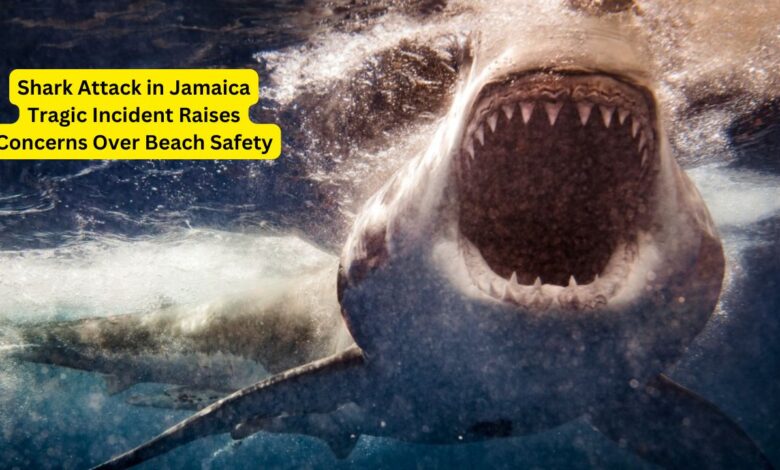Shark Attack in Jamaica Tragic Incident Raises Concerns Over Beach Safety

In a chilling and tragic event that has shocked both locals and tourists alike, a shark attack resulted in the death of a teenager on a Jamaican beach. This horrifying incident has raised urgent questions about safety in popular swimming areas and the need for effective measures to prevent such tragedies. As the news spreads, it brings to light the often-overlooked dangers that lurk beneath the ocean’s surface, even in seemingly safe and serene vacation spots.
The Tragic Incident: A Closer Look
The tragic event occurred at a popular beach in Jamaica, known for its stunning beauty and crystal-clear waters. The teenage victim, who was enjoying a day out at the beach, was suddenly attacked by a shark. Eyewitnesses reported that the attack was sudden and vicious, leaving no time for rescue. The shark’s powerful jaws inflicted fatal wounds, and despite immediate attempts to save the young swimmer, he tragically succumbed to his injuries.
This attack marks a rare but deeply alarming incident for Jamaica, a country that relies heavily on its tourism industry. The serene beaches and friendly waters are key attractions for tourists, and such incidents have the potential to significantly impact public perception and tourist behavior.
Shark Attacks: Understanding the Risks
Shark attacks are relatively rare, but when they do occur, they often grab global headlines due to their violent nature and the deep-seated fear they evoke. According to statistics, the likelihood of being attacked by a shark is extremely low, with millions of people swimming in oceans worldwide every year with no incidents. However, the potential for danger always exists, especially in certain geographical locations and under specific conditions.
Why Do Sharks Attack?
There are several reasons why sharks might attack humans:
- Mistaken Identity: The most common explanation is that sharks mistake humans for their natural prey, such as seals or fish. In murky water or in the chaos of splashing swimmers, a shark might strike, believing it is attacking its usual food source.
- Curiosity: Sharks are naturally curious creatures. They might bite as a means of exploration, much like how dogs use their mouths to investigate objects. Unfortunately, even a “test bite” from a shark can be dangerous or fatal due to their powerful jaws and sharp teeth.
- Territorial Behavior: Sharks, like many other animals, can be territorial. If they feel their space is being invaded, they might attack to ward off perceived threats.
Types of Sharks Involved in Attacks
While there are over 400 species of sharks, only a handful are responsible for the majority of attacks on humans. The species most commonly involved in unprovoked attacks include:
- Great White Shark: Known for its size and strength, the Great White is often feared due to its role in numerous high-profile attacks.
- Tiger Shark: These sharks are found in warm, tropical waters and are known for their willingness to eat a variety of prey, including humans.
- Bull Shark: These are considered one of the most dangerous sharks due to their aggressive nature and ability to swim in both saltwater and freshwater, bringing them closer to human activity.
It is yet to be confirmed which type of shark was responsible for the attack in Jamaica. Authorities and marine biologists are investigating to determine the species involved, which may provide clues to why this attack occurred.
Beach Safety Measures: Reducing the Risk of Shark Attacks
In the wake of this tragedy, there is an urgent call for enhanced safety measures to protect beachgoers. While it is impossible to eliminate the risk entirely, there are several effective strategies that can be implemented to significantly reduce the likelihood of shark attacks:
1. Shark Nets and Barriers
Installing shark nets or barriers around popular swimming areas is a common preventive measure in many coastal regions. These nets are designed to keep sharks away from beaches without harming them. Although not foolproof, they can greatly reduce the risk of encounters.
2. Shark Spotting Programs
Some beaches around the world employ shark spotters who are trained to detect the presence of sharks. These spotters use high vantage points and advanced technology, such as drones, to monitor the waters. When a shark is sighted, warnings can be quickly issued to swimmers and surfers, allowing them to evacuate the water.
3. Public Awareness and Education
Educating the public about the risks and safe practices is crucial. This includes advising swimmers to avoid wearing shiny jewelry, which can attract sharks, and to stay away from areas where sharks are known to feed, such as near fishing boats or where there are schools of fish. Beachgoers should also be informed about the times when shark activity is likely to be higher, such as during dawn or dusk.
4. Emergency Preparedness
Having emergency response plans in place can save lives. This includes training lifeguards in first aid and ensuring that medical supplies, such as tourniquets, are readily available. Quick response to shark attack victims is critical in preventing fatal outcomes.
The Role of Authorities and Local Communities
The Jamaican authorities are under pressure to address the concerns raised by this incident. Enhancing safety measures, such as increased surveillance and warning systems, will be crucial in restoring public confidence. Cooperation between local communities, tourism officials, and marine biologists is essential to develop and implement strategies that ensure the safety of both residents and visitors.
Local communities also play a significant role in fostering a culture of safety and respect for marine life. Promoting responsible swimming practices and educating the public about the importance of preserving shark populations can help strike a balance between human activity and the natural behavior of these marine predators.
Respecting the Ocean: Coexistence with Marine Life
While shark attacks are tragic, it is important to remember that sharks are an essential part of the ocean ecosystem. They play a crucial role in maintaining the balance of marine life by controlling the population of other species. The presence of sharks is often an indicator of a healthy ocean environment.
Efforts to reduce shark attacks should not lead to fear or hostility towards these creatures. Instead, they should promote a better understanding of shark behavior and encourage measures that allow humans to coexist safely with marine life. Conservation efforts are essential to ensure that shark populations are protected, and marine ecosystems remain balanced.
Moving Forward: Healing and Prevention
The recent shark attack in Jamaica is a sobering reminder of the unpredictability of nature and the need for vigilance when interacting with the ocean. As the community mourns the loss of a young life, there is a collective responsibility to learn from this tragedy and take proactive steps to prevent future incidents.
The implementation of enhanced safety measures, public education, and respectful coexistence with marine life are key to ensuring that beachgoers can continue to enjoy the beauty of Jamaica’s coastline without fear. By working together, authorities, communities, and individuals can make the ocean a safer place for all.




